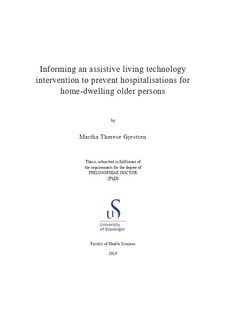| dc.contributor.advisor | Testad, Ingelin | |
| dc.contributor.author | Gjestsen, Martha Therese | |
| dc.date.accessioned | 2019-04-09T11:30:36Z | |
| dc.date.available | 2019-04-09T11:30:36Z | |
| dc.date.issued | 2019-04 | |
| dc.identifier.isbn | 978-82-7644-833-7 | |
| dc.identifier.issn | 1890-1387 | |
| dc.identifier.uri | http://hdl.handle.net/11250/2593852 | |
| dc.description.abstract | This thesis describes the process of planning an assistive living technology intervention for home-dwelling older persons receiving community care. The use of such technologies in the community care setting is heralded as one answer to address the challenges facing the health care system, as well as a mean for the health and care services to improve, simplify and enhance the efficiency of their activities.
Although the implementation of assistive living technologies is complex, the implementation is informed basically in two ways—directly, based on empirical reports, or indirectly, through systematic or meta-analytic reviews. The main objective of this thesis is to provide a theory and evidence-based rationale for applying an assistive living technology intervention in community care to prevent hospitalisations for older persons.
By using hospital admissions which may be prevented as a case, exploring health care personnel’s and managers’ perspectives, and furthermore using existing theories and research concerning implementation, we have applied both an empirical and theoretical approach to inform a future assistive living technology intervention in the defined context.
A socio-technical perspective has been applied; the different stakeholders involved on different organisational levels and the framework conditions constitute the socio technical system in the study, implying that a multi-level approach is appropriate to help identify potential barriers and incentives for the implementation of assistive living technologies in community care. Furthermore, has the Model for Understanding Success in Quality (MUSIQ) provided guidance to identify contextual factors likely to influence a future implementation process. | nb_NO |
| dc.language.iso | eng | nb_NO |
| dc.publisher | University of Stavanger, Norway | nb_NO |
| dc.relation.ispartofseries | PhD thesis;446 | |
| dc.relation.haspart | Paper 1: Gjestsen, MT, Brønnick, K., Testad, I. (2018).Characteristics and predictors for hospitalizations of home-dwelling older persons receiving community care: a cohort study from Norway. BMC Geriatrics BMC Geriatrics. doi: 10.1186/s12877-018-0887-z | nb_NO |
| dc.relation.haspart | Paper 2: Gjestsen, MT, Wiig, S., Testad, I. (2017). What are the key contextual factors when preparing for successful implementation of ALT in primary elderly care? A case study from Norway. BMJ Open. doi: 10.1136/bmjopen-2016-015455 | nb_NO |
| dc.relation.haspart | Paper 3: Gjestsen, MT, Wiig, S., Testad, I. (Manuscript). Health care personnel’s perspective on potential eHealth interventions to prevent hospitalizations for older persons receiving community care. A case study. JMIR Preprints. 12/11/2018:12797 DOI: 10.2196/preprints.12797 Submitted (November 2018) to Journal of Medical Internet Research | nb_NO |
| dc.subject | elderly patients | nb_NO |
| dc.subject | eldre pasienter | nb_NO |
| dc.subject | eldreomsorg | nb_NO |
| dc.subject | assistive living technology | nb_NO |
| dc.title | Informing an assistive living technology intervention to prevent hospitalisations for home-dwelling older persons | nb_NO |
| dc.type | Doctoral thesis | nb_NO |
| dc.rights.holder | © 2019 Martha Therese Gjestsen | nb_NO |
| dc.subject.nsi | VDP::Medical disciplines: 700::Clinical medical disciplines: 750::Geriatrics: 778 | nb_NO |
